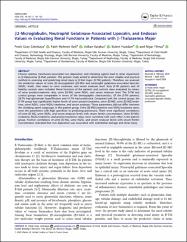| dc.contributor.author | Çetinkaya, Petek Uzay | |
| dc.contributor.author | Azık, Fatih Mehmet | |
| dc.contributor.author | Karakuş, Volkan | |
| dc.contributor.author | Huddam, Bülent | |
| dc.contributor.author | Yılmaz, Nigar | |
| dc.date.accessioned | 2020-11-20T14:39:31Z | |
| dc.date.available | 2020-11-20T14:39:31Z | |
| dc.date.issued | 2020 | |
| dc.identifier.issn | 0363-0269 | |
| dc.identifier.issn | 1532-432X | |
| dc.identifier.uri | https://doi.org/10.1080/03630269.2020.1766486 | |
| dc.identifier.uri | https://hdl.handle.net/20.500.12809/474 | |
| dc.description | Azik, Fatih/0000-0001-5715-4244; karakus, volkan/0000-0001-9178-2850 | en_US |
| dc.description | WOS: 000539665000001 | en_US |
| dc.description | PubMed ID: 32441176 | en_US |
| dc.description.abstract | Chronic anemia, transfusion-associated iron deposition, and chelating agents lead to renal impairment in beta-thalassemia (beta-thal) patients. The present study aimed to determine the most reliable and practical method in assessing and predicting renal injury in beta-thal major (beta-TM) patients. Therefore, we assessed the predictive values of urine beta 2-microglobulin (beta 2-MG) and neutrophil gelatinase-associated lipocalin (NGAL) levels, their ratios to urine creatinine, and serum endocan level. Sixty beta-TM patients and 30 healthy controls were included. Renal functions of the patients and controls were evaluated by means of urine protein/creatinine ratio, urine beta 2-MG, urine NGAL, and serum endocan level. The beta-TM and control groups were comparable in terms of the demographic characteristics. Of the beta-TM patients, 26.7% had glomerular hyperfiltration and 41.7% had proteinuria. Compared with the control group, the beta-TM group had significantly higher levels of urine protein/creatinine, urine beta 2-MG, urine beta 2-MG/creatinine, urine NGAL, urine NGAL/creatinine, and serum endocan. These parameters did not differ between the chelating agent subgroups in the patient group. Urine beta 2-MG/creatinine and NGAL/creatinine ratios were the parameters with high specificity in predicting proteinuria. There were significant correlations of urine beta 2-MG, urine NGAL, and serum endocan levels with serum ferritin concentration. Urine beta 2-MG/creatinine, NGAL/creatinine, and protein/creatinine ratios were correlated with each other in the patient group. Positive correlations of urine beta 2-MG, urine NGAL, and serum endocan levels with serum ferritin concentration indicated that iron deposition was associated with endothelial damage and renal injury. | en_US |
| dc.description.sponsorship | Mugla Sitki Kocman University Scientific Research Projects UnitMugla Sitki Kocman University [16/133] | en_US |
| dc.description.sponsorship | The study was supported by the Mugla Sitki Kocman University Scientific Research Projects Unit with the project number 16/133. | en_US |
| dc.item-language.iso | eng | en_US |
| dc.publisher | Taylor & Francis Ltd | en_US |
| dc.item-rights | info:eu-repo/semantics/openAccess | en_US |
| dc.subject | Beta-Thalassemia Major (Beta-TM) | en_US |
| dc.subject | Beta 2-Microglobulin (Beta 2-MG) | en_US |
| dc.subject | Endocan | en_US |
| dc.subject | Neutrophil Gelatinase-Associated Lipocalin (NGAL) | en_US |
| dc.subject | Proteinuria | en_US |
| dc.title | beta 2-Microglobulin, Neutrophil Gelatinase-Associated Lipocalin, and Endocan Values in Evaluating Renal Functions in Patients with beta-Thalassemia Major | en_US |
| dc.item-type | article | en_US |
| dc.contributor.department | MÜ, Tıp Bilimleri, Dahili Tıp Bilimleri | en_US |
| dc.contributor.institutionauthor | Çetinkaya, Petek Uzay | |
| dc.contributor.institutionauthor | Azık, Fatih Mehmet | |
| dc.contributor.institutionauthor | Karakuş, Volkan | |
| dc.contributor.institutionauthor | Huddam, Bülent | |
| dc.contributor.institutionauthor | Yılmaz, Nigar | |
| dc.identifier.doi | 10.1080/03630269.2020.1766486 | |
| dc.identifier.volume | 44 | en_US |
| dc.identifier.issue | 3 | en_US |
| dc.identifier.startpage | 147 | en_US |
| dc.identifier.endpage | 152 | en_US |
| dc.relation.journal | Hemoglobin | en_US |
| dc.relation.publicationcategory | Makale - Uluslararası Hakemli Dergi - Kurum Öğretim Elemanı | en_US |


















